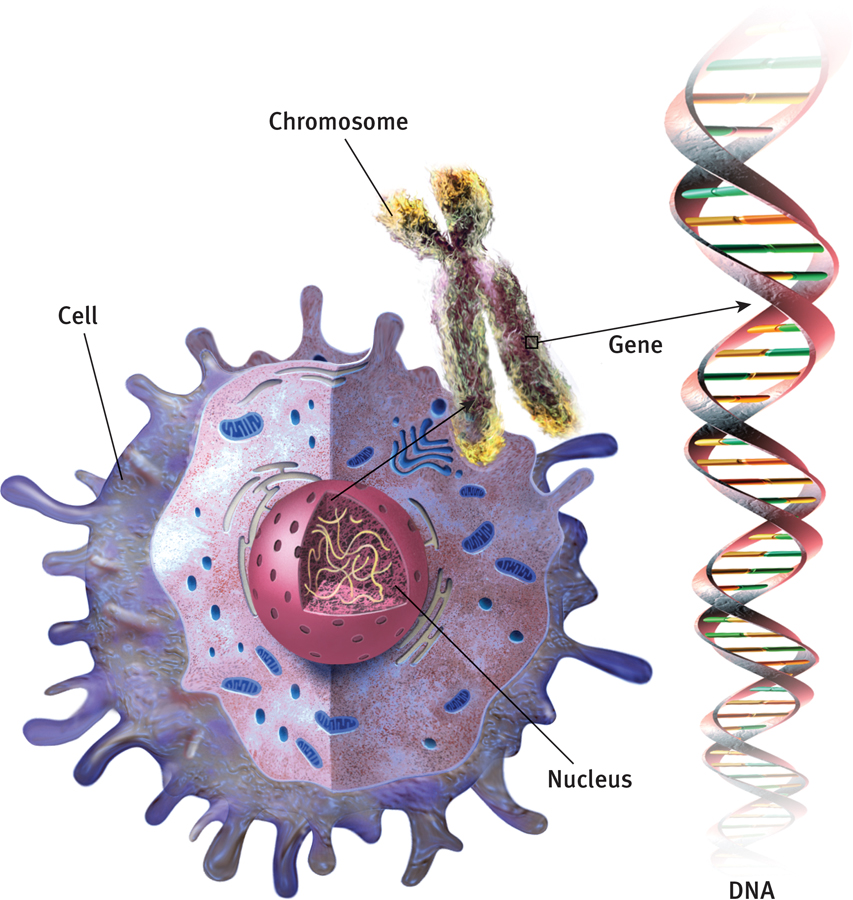11.1 Genes: Our Codes for Life
Behind the story of our body and of our brain—surely the most awesome thing on our little planet—is the heredity that interacts with our experience to create both our universal nature and our individual and social diversity. Barely more than a century ago, few would have guessed that every cell nucleus in your body contains the genetic master code for your entire body. It’s as if every room in Dubai’s Burj Khalifa (the world’s tallest building) contained a book detailing the architect’s plans for the entire structure. The plans for your own book of life run to 46 chapters—23 donated by your mother’s egg and 23 by your father’s sperm. Each of these 46 chapters, called a chromosome, is composed of a coiled chain of the molecule DNA (deoxyribonucleic acid). Genes, small segments of the giant DNA molecules, form the words of those chapters (FIGURE 11.1). All told, you have 20,000 to 25,000 genes, which are either active (expressed) or inactive. Environmental events “turn on” genes, rather like hot water enabling a tea bag to express its flavor. When turned on, genes provide the code for creating protein molecules, our body’s building blocks.

 Figure 11.1
Figure 11.1The life code The nucleus of every human cell contains chromosomes, each of which is made up of two strands of DNA connected in a double helix. Genes are DNA segments that, when expressed (turned on) direct the development of proteins that influence a person’s individual development.
Genetically speaking, every other human is nearly your identical twin. Human genome researchers have discovered the common sequence within human DNA. This shared genetic profile makes us humans, rather than tulips, bananas, or chimpanzees.
“We share half our genes with the banana.”
Evolutionary biologist Robert May, president of Britain’s Royal Society, 2001
We aren’t all that different from our chimpanzee cousins. At a genetic level, humans and chimpanzees are 96 percent identical (Mikkelsen et al., 2005). At “functionally important” DNA sites, this number reaches 99.4 percent (Wildman et al., 2003)! Yet that wee 0.6 percent difference matters. Shakespeare intricately wove 17,677 words into his literary masterpieces. Despite some remarkable abilities, chimpanzees do not compose sonnets.
Small differences matter among other species, too. Common chimpanzees and bonobos resemble each other in many ways. They should—their genomes differ by much less than 1 percent. But they display markedly differing behaviors. Chimpanzees are aggressive and male dominated. Bonobos are peaceable and female led.
“Your DNA and mine are 99.9 percent the same…. At the DNA level, we are clearly all part of one big worldwide family.”
Francis Collins, Human Genome Project director, 2007
The occasional variations found at particular gene sites in human DNA fascinate geneticists and psychologists. Slight person-to-person variations from the common pattern give clues to our uniqueness—why one person has a disease that another does not, why one person is short and another tall, why one is anxious and another calm.
Most of our traits have complex genetic roots. How tall you are, for example, reflects the size of your face, vertebrae, leg bones, and so forth—each of which may be influenced by different genes interacting with your specific environment. Traits such as intelligence, happiness, and aggressiveness are similarly influenced by groups of genes. Thus, our genes help explain both our shared human nature and our human diversity. But knowing our heredity tells only part of our story. To form us, environmental influences interact with our genetic predispositions.
RETRIEVAL PRACTICE
- Put the following cell structures in order from smallest to largest: nucleus, gene, chromosome
gene, chromosome, nucleus
- When the mother’s egg and the father’s sperm unite, each contributes 23 _________.
chromosomes